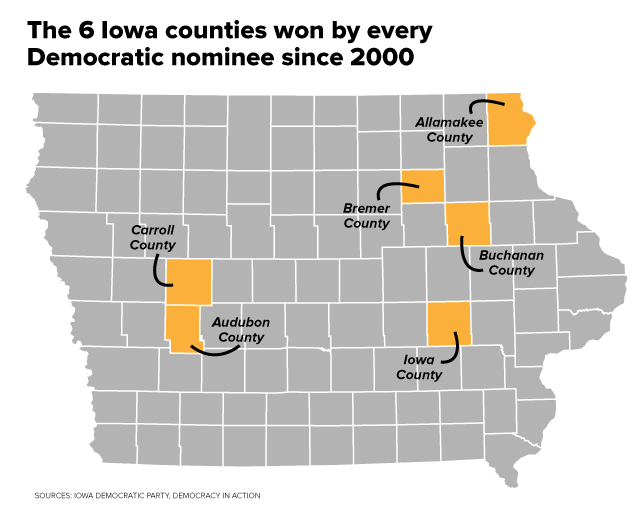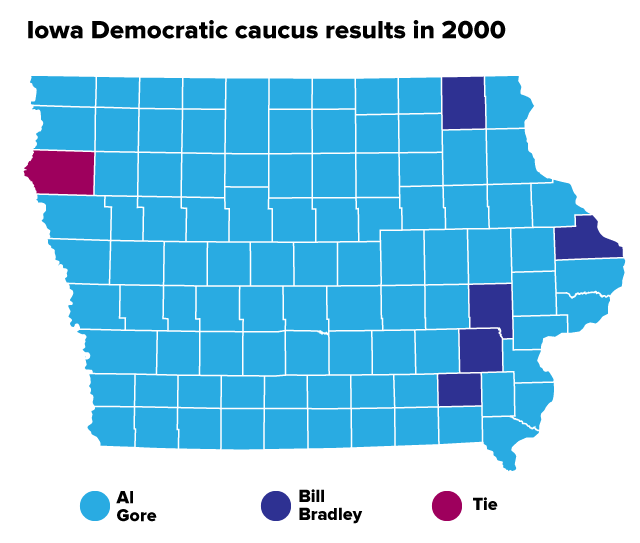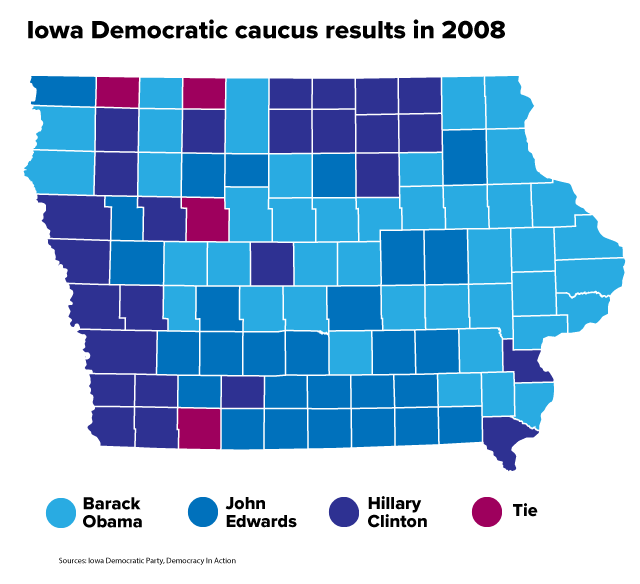The Iowa Democratic caucuses, mapped
For a town of about 10,000 residents, Waverly, Iowa, attracts more than its share of presidential candidates.
Former Rep. John Delaney (D-Md.) has visited four times. Businessman Andrew Yang has stopped by twice, most recently last week. On Sunday, former Vice President Joe Biden brought Reps. Chrissy Houlahan (D-Pa.) and Colin Allred (D-Texas) to make his case.
They come for more than the scenery. Waverly, and surrounding Bremer County, play an important if symbolic role in the battle for the Democratic presidential nomination, and eventually the White House.
Bremer is one of six counties in Iowa that has voted for the winner of each of the last four Democratic presidential caucuses. It has also voted for the winning presidential candidate in every November election since 1980.

When Iowa Democrats head to school cafeterias, gymnasiums and community centers across the state next Monday, their decisions will mark the beginning of a five-month sprint across primaries and caucuses throughout the country.
History says Iowa’s results will give a strong hint of the eventual winner: The last four Iowa winners have all gone on to claim the nomination.
But the significant number of strong candidates running this year hints at the prospect of a divided result — one similar to the narrow contests in recent years. Every race is crowded with a different ideological mix of candidates, and every race is won in different fashion.
When the results come in, history shows three key Democratic cores will be crucial to the winning candidate.
The first is in Polk County, home of Des Moines, where the largest crush of voters are expected.
Polk County Democrats have picked the winning candidate in three of the last four caucuses, only missing in 2004 when voters chose then-Sen. John Edwards (D-N.C.) over the statewide winner, then-Sen. John Kerry (D-Mass.).
The second is in eastern Iowa, in counties along the Mississippi River, where labor unions and traditional blue-collar Democrats mix with younger students at and around the University of Iowa.
Those counties — Johnson and Linn in particular — gave Kerry his margins in 2004, backed former President Obama heavily in 2008 and gave Sen. Bernie Sanders (I-Vt.) enough of a margin to help him come within an inch of beating Hillary Clinton in 2016.
“Well over half of the Democratic vote in Iowa is cast east of I-35, so wins there net more numbers than they do in most other counties,” said David Yepsen, the veteran Iowa political observer and host of the public affairs show “Iowa Press.”
But Iowa’s caucus rules also mean the Democratic candidates cannot overlook small towns like Waverly and its rural counterparts. Rural Iowa, the third region that matters, gets a disproportionate number of delegates, akin to the federal electoral college.
“The delegate value is not always reflected in the county or the population of the county,” said Matt Paul, who led Clinton’s 2016 campaign, where she walloped Sanders in most rural counties. “These candidates and their campaigns have to engage at a local, smaller level than you would at a primary.”
Here are the ways the last four contested caucuses played out:
2000: The Blowout
Sen. Bill Bradley (D-N.J.) seemed to have momentum after winning the coveted endorsement of the Des Moines Register. Democratic voters were unmoved, and Vice President Al Gore won 93 of 99 counties, with 63 percent of the delegate share.
Bradley managed to win Johnson County, home of the Iowa Hawkeyes, and two neighboring counties to the south. Gore won just about everything else.

2004: River to River
The race to face President George W. Bush featured four contenders with a real shot to win, and early polls showed House Minority Leader Richard Gephardt (D-Mo.) in the lead, 16 years after he won the Iowa caucuses in 1988. But Gephardt and former Vermont Gov. Howard Dean (D) clashed hard in the closing weeks of the race, while Kerry and Edwards came on strong at the end.
Kerry’s win came on the strength of his performances in Iowa’s river counties. He dominated along the Missouri River, where he won six of the nine counties that border South Dakota and Nebraska, and along the Mississippi, where he won eight of ten counties.
Kerry kept the margins close in Polk County, where Edwards beat him by 50 delegates — the same number Kerry netted out of Linn County, half the size of Polk.
Dean limped into third place, winning just three counties. Gephardt collapsed into a distant fourth.

2008: The Illinois Influence
A crowded Democratic field had winnowed itself to three main contenders by the time Iowans gathered in seven-degree weather on an early January night. The results showed Obama, Clinton and Edwards winning in three entirely different areas.
Clinton’s biggest wins came in western Iowa, along the Missouri River, from Sioux City south into Council Bluffs and more rural areas. Edwards took his biggest wins in southern rural counties, along the border with Missouri.
But Obama’s coalition was the broadest of the night. He carried Polk County by a wide margin, netting more than a third of the 1,200 state delegates at stake, compared to about a quarter for Clinton and Edwards. Obama scored big wins in Johnson and Linn, and in all but two counties that bordered his home state of Illinois.

2016: The Urban-Rural Union
Obama’s 2008 performance showed a campaign could win statewide by winning two of the three regions in the state, Des Moines and the eastern college and labor towns. Eight years later, Clinton used a coalition of urban Des Moines and rural communities to just barely edge out Sanders.
Clinton’s highest vote share came in Polk County, where she beat Sanders by 7 points. But her most critical votes came in smaller rural counties, many of which broke for the front-running Democrat by 2 to 1 margins.
That helped offset Sanders’s better performance in the eastern counties and in Council Bluffs and Sioux City, both areas Clinton had won eight years before. Sanders actually netted more votes out of Johnson County than Clinton did in Polk, even though Polk is three times Johnson’s size.
By the time the votes were tallied, and after 14 precincts merited special attention from the state Democratic Party, Clinton had won the narrowest victory in any Democratic caucus held in Iowa — a margin of just 0.3 percentage points.

Copyright 2024 Nexstar Media Inc. All rights reserved. This material may not be published, broadcast, rewritten, or redistributed..











